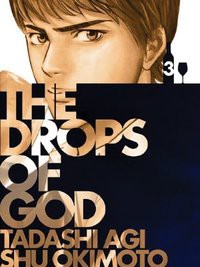RIGHT TURN ONLY!!
Is This RTO!?
by Carlo Santos,

April may be one of the absolute best months. Not only does it hold the promise of new anime shows, but it also signals the start of baseball season. Which reminds me ... I need to get caught up on Cross Game!
BAKUMAN

Vol. 10
(by Tsugumi Ohba and Takeshi Obata, Viz Media, $9.99)
FROM THE BACK COVER:
"Average student Moritaka Mashiro enjoys drawing for fun. When his classmate and aspiring writer Akito Takagi discovers his talent, he begs Moritaka to team up with him as a manga-creating duo. But what exactly does it take to make it in the manga-publishing world?
Moritaka and Akito will need to come up with an amazing new manga idea if they ever hope to get back into Weekly Shonen Jump magazine, and they only have six months to do it! But with Hattori, their former editor, helping behind the scenes, the duo might have everything in place to create the perfect story."
EVIDENCE FOR:
Moritaka and Akito's do-or-die situation in this volume may not exactly be realistic ... but their creative process is, making this volume of Bakuman. another must-have for true manga enthusiasts. The first few chapters are a serious look into how ideas come to life: brainstorming, refining and analyzing, as much a how-to manual as it is an actual story. And that's not all—in the second half, we get to witness the drama between Shonen Jump's editors as they argue over whether to serialize the new story or not. It may not be as glamorous as being a manga artist, but the editorial side has its excitement as well. And just so the story's not stuck inside studios and offices all day, there's some legitimate action in the middle as Moritaka and Akito go stalking around town as part of their "research." The moods on the characters' faces add visual flair to the story—seriousness, passion, and elation are reflected in their expressions just as in their words. Obata's sharp, precise lines also make the artwork easy to follow amidst all the little background details that create the ambience of the manga-ka lifestyle.
EVIDENCE AGAINST:
Seeing Moritaka and Akito go from initial concept to serialization is a real thrill, but it comes at the cost of all the other characters' subplots. Remember how much fun it was seeing the "Ashirogi duo," Niizuma, Aoki, and all their fellow creators interacting and challenging each other? None of that happens here, because everyone's holed up in their studios, writing and drawing. That's the reality of the manga industry, and it inevitably makes the series less interesting. Any updates on the side characters are basically brief scenes that say, "So-and-so is still hard at work," and sometimes, "So-and-so is wondering what the other guys are up to." In addition, the extreme awkwardness with female characters continues: Miho and Kaya are treated as mere cheerleaders for Akito and Takagi, and a one-sided romance between an editor and writer is just contrived and painful to watch. Meanwhile, the blocks of text crowding every single panel is the biggest visual problem as usual. Ironically, one of the last chapters mentions some tips about panel variety, spacing, and silent moments ... yet the Ohba-Obata team can't even take their own advice.
FINAL VERDICT:
If it could get the side characters more involved, and stopped being so wordy, it'd be perfect. But even as it is, this in-depth portrayal of manga creation (and manga editing) still earns a B-.
THE DROPS OF GOD

Vol. 3
(by Tadashi Agi and Shū Okimoto, Vertical, $14.95)
FROM THE BACK COVER:
"The first of the heaven-sent bottles is revealed in these pages. No less gripping: the dramas of memory that unfold as Shizuku helps out an amnesiac painter, Chosuke hears from the French lady of his unrequited longings, and Miyabi meets a former classmate turned newly-rich snob for whom wines are but brands."
EVIDENCE FOR:
Amnesia is sometimes seen as a lazy writer's plot device, but Drops of God does it right in this volume—a lost memory opens the way to a fact-finding mystery, a tragic romance, and the first clue to Shizuku's epic wine quest. It's like multiple stories at once, so don't let anyone ever say that this series is merely a technical guide to wine. Even better, the human element resonates strongly within the story, with passionate desires and troubled feelings all part of the equation. The showdown between Shizuku and rival Issei in the volume's second half is less complex, but still plenty exciting, with tension and competitive ardor in the tasting room. Even supporting characters get their moments in the spotlight as they recall key moments in their lives that are tied to the art and craft of wine. Speaking of art and craft, the visuals continue to impress with each of Shizuku's "reaction shots"—pristine forests, towering castles, and ancient ruins add a touch of fantasy to this down-to-earth subject. But it also makes sure to get the basics right, from solid character designs to clean panel layouts that move the story along smoothly.
EVIDENCE AGAINST:
The last few chapters in this volume demonstrate the exact kind of problem that Drops of God should be careful to avoid: information overload. The rundown of France's five most prestigious winemakers becomes a victim of its own encyclopedic detail, where names and data are more important than actual story. Shizuku's reactions still make things interesting, but cramming all those images one after another makes them less special than when they're spaced out in between story developments. Also, the conflicts in the volume's second half suffer from poorly written antagonists—bad guys like Issei (the smug wine critic) and Takasugi (the brand-name-obsessed entrepreneur) lack the realness of the main characters, seeming more like cackling villain stereotypes. Simple-minded viewpoints like "Money and prestige is all that matters!" belong in a fantastical Shonen Jump adventure ... and even then the editors would ask for the characters to be more fleshed out. Sometimes the artwork also has a stiff look to it; static landscapes come out fine but there's no sign of life when characters are in motion. Even the characters' basic expressions look a bit dead because of the precise, realistic style.
FINAL VERDICT:
A complex, interwoven storyline in the first half is let down a bit by the incessant name-dropping in later chapters. But the content and the art is still engaging enough for a B.
DURARARA!!

Vol. 2
(by Ryohgo Narita, Akiyo Satorigi and Suzuhito Yasuda, Yen Press, $11.99)
FROM THE BACK COVER:
"Mikado is an average high-schooler whose life has been anything but since moving to Ikebukuro! After coming face to—neck?—with the legendary 'headless rider,' Mikado can hardly wait to encounter more of the city's peculiar residents. But when Mikado is caught in the middle of a feud between Izaya Orihara and Shizuo Heiwajima, he soon realizes that Ikebukuro's most unbelievable characters are also among its most dangerous..."
EVIDENCE FOR:
So many characters, so many storylines ... and not a bad one among them. Durarara!! really starts to show its range in Volume 2, opening with a haunting chapter about the origins of headless rider Celty—a seamless blend of ancient folktale and modern myth. Then comes the moment everyone's been waiting for: the arrival of Shizuo Heiwajima, tossing trash cans and street poles and being an endless source of amusement. Just as interesting—though sadly not as well-loved—is the story of stalker schoolgirl Mika Harima, as well as the bizarre crush that Seiji Yagiri (Mikado's classmate) is trying to keep secret. Best of all, these odd, disparate characters are all connected by a still-evolving network of storylines, one involving kidnappings and street gangs and secret medical research. The series is always fascinating and never formulaic, mainly because it's got too many moving parts to fit into a single formula. The sharp, stylish artwork adds to the fun, whether it be Shizuo's over-the-top feats of strength or the stark imagery of Celty's origin story. Light, clean lines keep the visuals from getting too cluttered, making this volume another fun, fast-paced read.
EVIDENCE AGAINST:
What makes Durarara!! so great is also what makes it so frustrating: just when you think you've gotten into the flow of it, it suddenly jumps somewhere else in the plot, and now it's time to re-learn what's going on and who's involved. This can be especially problematic when the storyline just isn't very interesting—like an interrogation scene in the back of a van, which reveals some important information but in itself isn't very entertaining. Then there are the times when the characters are great, but the story itself shows little purpose, like Izaya and Shizuo clashing on the streets of Ikebukuro. They're both pretty cool guys, but ... what was the point of that chapter again? The haphazard, jumping-from-point-to-point approach also means that some plot points aren't explored deeply enough, resulting in vagueness and unanswered questions. One could also say that the artwork is vague, with too many blank white areas and a lack of backgrounds. If this is to be a tale about the quirks of Ikebukuro, it'd be nice to actually see more of Ikebukuro, and fewer close-up dialogue scenes.
FINAL VERDICT:
The bouncing between multiple storylines may not suit everyone's tastes, but that's part of the series' charm, along with distinctive characters and sheer originality that adds up to yet another A-.
IS THIS A ZOMBIE?

Vol. 1
(by Sacchi, Shinichi Kimura and Kobuichi•Muririn, Yen Press, $11.99)
FROM THE BACK COVER:
"Life (or undeath?) isn't easy for Ayumu Aikawa. A seemingly normal high schooler, he is in fact a zombie serving as bodyguard to an introverted necromancer. This already-complicated existence becomes even more outlandish when he accidentally steals the powers of a 'Magikewl Girl,' transforming into one himself! How's a reanimated corpse supposed to keep his head on his shoulders with roommates like these girls around the house?"
EVIDENCE FOR:
The secret of Is This a Zombie? ... is that it barely has anything to do with zombies. Rather, it's about poking fun at every possible element of genre fiction—in addition to a totally average-Joe zombie, you've got necromancers, vampire ninjas, "magically dressed" girls (and cross-dressing boys), and evil monsters taking the form of oversized animals. No target is safe from the series' irreverence, and it only gets better when the characters clash with each other: back-and-forth banter, slapstick outtakes, and ridiculous puns are often the result of these encounters. Yet the story takes time to build its serious side as well, as Ayumu explains his unusual relationship with live-in necromancer Eucliwood and strives to understand her cryptic ways later on. Indeed, the sudden twist in the final scene suggests that this is not just a pile-up of goofy gags. Such an oddball cast lends itself naturally to memorable character designs—this series' magical-combat getup includes frilly dresses, suits of armor, and chainsaws. That's right, chainsaws. And even in scenes of everyday life, the pages burst forth with visual energy as the characters go wild.
EVIDENCE AGAINST:
It's one thing to poke fun at zombies and sorcerers and magical girls ... but another thing to actually do it well. Like so many third-rate comedies, this one confuses humor with screaming as loud as possible, and most of the gags involve the characters saying outrageous things or reacting to them. The over-reliance on otaku fetishes doesn't help, either: by about the fifth time Ayumu fantasizes about being called "onii-chan," it's no longer stupidly endearing, it's just annoying (and a tad creepy too). The random in-jokes about other anime franchises also shows a lack of creativity, as if referencing some other series will elicit a laugh because you can't think of your own punchline. And as for the story having any sense of purpose? Forget it. Artwork is a mess as well; what looks like madcap energy is really just poorly organized paneling, where the characters and their dialogue bubbles try to fit themselves into any space available. The somewhat cartoony style also makes the character designs less impressive than they could really be, like with Ayumu's striking-but-not-terribly-detailed magical outfit or the monsters just being mega-sized mascots.
FINAL VERDICT:
In its quest for humor, this one falls awkwardly on its own dull blade. The premise sounds funny at first, but the poorly thought-out gags earn it a C-.
TORADORA!

Vol. 4
(by Yuyuko Takemiya and Zekkyō, Seven Seas, $11.99)
FROM THE BACK COVER:
"After endless strife, Ryuuji and Taiga have finally found some common ground and can at least tolerate each other (sort of). Their relationship may be on shaky ground, but it's their disdain for popular teen model and recent transfer student Kawashima Ami that unites them.
The battle with Ami has moved to a new front: swim class! A tasteless insult cannot go unpunished. There will be war (in the pool) and the winner will take Ryuuji as her spoils."
EVIDENCE FOR:
Once again, Toradora! takes familiar school scenarios and executes them at a surprisingly high level. For example, it isn't just enough for the kids to poke fun at each other's body types when they get to the pool—this time, Ryuuji and Taiga hatch up a ridiculous plan to secretly enhance her curves. (So ridiculous, in fact, that it actually works...) The real highlight comes a few chapters later, though, when Taiga and Ami meet for a swimming race that comes complete with trash-talk, cheating, and near-drowning. It's impossible to find a romantic rivalry boring when the humor that comes out of it is so entertaining. The growing bond between Ryuuji and Taiga is another part of the series' high-spirited charm; behind the harsh words and arguments, the story makes it clear that there really is a genuine attachment between the two. The artwork also helps in bringing those emotions across—the impassioned facial expressions and sometimes-goofy reactions allow us to really see what the characters are feeling. Outbursts of physical comedy also make a strong visual impression, and the clean, uncluttered panels move the story forward with ease.
EVIDENCE AGAINST:
Although Toradora!'s poolside storyline comes out better than average, it still makes some run-of-the-mill mistakes, like having the boys make embarrassing catcalls when Ami steps out in a swimsuit. The first rule of good fanservice is, you don't purposely call attention to the fanservice. That's just awkward. There's also an odd subplot that never gets fully resolved—Ryuuji gets fired up after finding out about a wager on the swimming race, but it's never mentioned again afterward. Too much dialogue is also a problem throughout this volume: it's fun at first when Ryuuji and Taiga go at it, but when their arguments spill into multi-page territory, it starts to look more like talking in circles rather than forward progress. This gets worse when other characters join in, like in the chapter where everyone starts discussing the summer trip to Ami's house. If you've ever tried to get five friends to agree on something, well, this obviously isn't the most exciting story material. It's made even less interesting by artwork that skimps on backgrounds and squeezes the characters into a corner when the dialogue gets too heavy.
FINAL VERDICT:
Despite its imperfections, this volume is another strong entry in the series, with lively character interactions and comedy moments that add up to a B.

SOULLESS

Vol. 1
(by Gail Carriger and Rem, Yen Press, $12.99)
FROM THE BACK COVER:
"The life of a spinster in Victorian London isn't an easy one on the best of days, but such a life becomes infinitely more complicated when said spinster is 'soulless'—a preternatural bridging the gap between the natural and supernatural worlds. Miss Alexia Tarabotti has this unique distinction, and when she is assailed at a formal gathering by a Rove vampire, an encounter that results in the death of the half-starved creature, her circumstances become exponentially more complicated indeed!
Now caught up in an intrigue with life or death stakes, Alexia must rely on all her talents to outmatch the forces conspiring against her, but it may be the man who has caught her eye—Lord Conall Maccon—and their budding flirtation that truly drives her to her wit's end!"
EVIDENCE FOR:
Vampires, werewolves, and 19th-century England—at first it may look like Soulless is just jumping aboard the genre bandwagon with everyone else, but this one does it with more intelligence and flair. Readers will instantly notice the witty dialogue, where lead character Alexia has a snappy comeback for all the challenges society throws at her, and manages to do it in proper formal English. The story itself is just as smart, with elements that take it beyond the usual Victorian vampire-hunting formula: a dash of steampunk science, deep mysteries and conspiracies, and serious romantic sparks between Alexia and her werewolf suitor. Some adventures just have romance tacked on, but this one works it in as an integral part of the story, creating a more satisfying whole. The sure-handed artwork is satisfying as well, with detailed, accurate period costumes and character designs that remain absolutely consistent (and attractive) from page to page. Regular bursts of action add some visual excitement to the stately charm of old London, and the careful balance between black, white, and grey tones makes the artwork clean and easy to follow.
EVIDENCE AGAINST:
It's easy to fall in love with Soulless for its rich setting and appealing characters—but their interactions often fall flat. No matter how witty the dialogue, if people are just going to sit around and talk about their situation (which happens a lot), why even have a visual adaptation? The dialogue's wordiness is also a problem: not that it's clunky or anything, but the flowery turns of phrase don't feel right for a spoken conversation. Worse yet, it slows down the pacing. Fortunately we have action scenes to speed things up ... but those moments fall into their own predictable formula, where every chapter Alexia is inevitably attacked by a creature and then gets into a fight or chase. Only in the final confrontation does the physical fighting show signs of creativity. Finally, a lot of the story elements the characters mention are never explained in full detail—there's a rich world out there, and lots to learn about "preternaturals" and "vampire hives," but this first volume only scratches the surface.
FINAL VERDICT:
With all the chit-chat and scene-setting, it takes a while for the story to get moving, but once it does there's plenty to enjoy in this historical, supernatural (and romantic!) adventure.

Some of the best manga are the ones that hold universal truths, designed to last for years to come. This one came out in English in 2008, but if the name is new to you, check it out! Contributor Sarah Chin shares her thoughts on why it's worth your time.
SOLANIN

(by Inio Asano, Viz Media, $17.99)
From its description, Solanin does not promise much. The story of headstrong Meiko Inoue, a former country girl and recent college-graduate, sounds like any typical angsty slice-of-life story. Meiko works an office job she cannot stand while her boyfriend, Naruo, mooches off her and stays in her run-down apartment. Add in their three quirky friends from college and you have the recipe for a typical coming-of-age dramedy. What makes Solanin different is that Asano's astute observations about the twentysomething lifestyle are spot on. The feelings of the characters are captured perfectly and their issues are something most face at some point. The plot and problems of Solanin seem insignificant when compared to the plots of other manga where the characters are saving galaxies or fighting against the forces of evil. Rather, Solanin is poignant and quietly heartbreaking in the way it portrays the lives of the all too relatable characters.
Solanin's real strength lies in the people it creates. Meiko and Naruo are just typical young adults, which makes them so much more relatable. This, in turn, makes the story very plausible and realistic. Meiko's friends are hilarious and bring just the right amount of humor to the story. However, when tragedy strikes around the halfway mark, these supporting characters develop from one-dimensional comic relief into well-rounded characters that carry a lot of the action in the story, without losing the gags and punch lines.
Solanin's art is more true-to-life which is fitting of the realistic story. The characters do not all have giant eyes and long flowing hair; they look like normal people. Photographs were used in some of the larger backgrounds but it usually adds to the picture rather than detracts. That said, the art is nothing incredibly remarkable. Like the art, the layout is not extremely interesting. All use some combination of squares and rectangles to get the point across. It makes it easy to read but can be a bit boring. In addition, a lot of scenes tend to be cluttered with text bubbles.
In the end, Solanin's strong point is its characters and story. Meiko's story feels only too relevant in a society where the pressures of getting a job and conforming to social norms are prevalent in the lives of young people. While its art and layouts are not exactly on par with the story, they hold up the action well enough. Highly recommended.
Is there a hidden gem of manga you'd like to reveal to the world? Is there a piece of garbage that deserves to be bashed in public? Or is there a title that didn't get a fair grade here, and you want to set the record straight?
Now's YOUR chance to be the reviewer! Write a review of about 300-400 words (a little more or less is fine) and include:
- your name.
- Title of manga (and volume no., if applicable)
- Author/Artist
- Publisher
- Briefly describe the story, then explain why this manga is great, terrible, or in between. Be objective, but also be entertaining.
Then send it in to rtoreaders (at) gmail (dot) com (plain text format preferred). One review will be selected out of all the submissions and will be published in the next column. All types of manga and manga-inspired comickry are accepted, from past and present, from Japan and beyond—what matters is that it's the Reader's Choice! NOTE: Submissions may be edited for formatting and grammar.
discuss this in the forum (7 posts) |